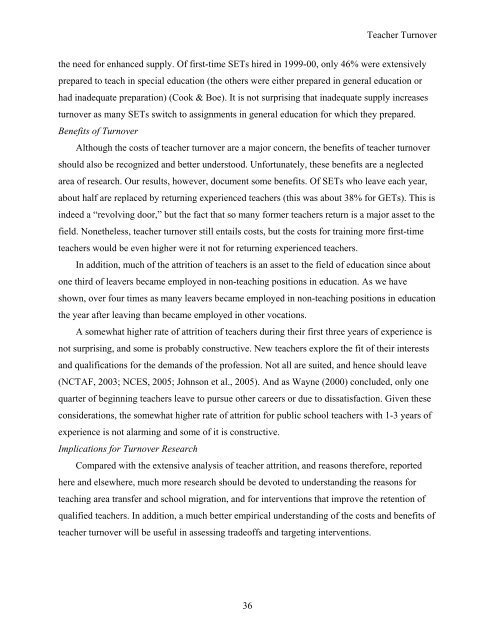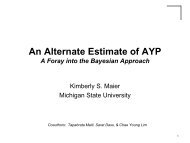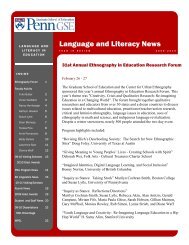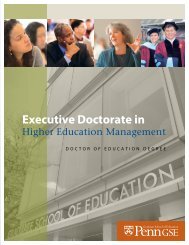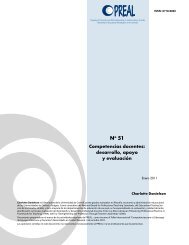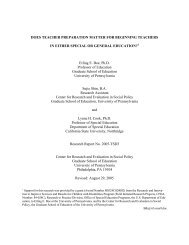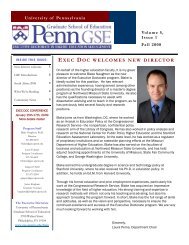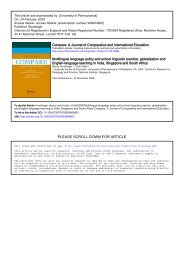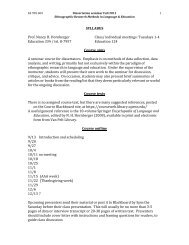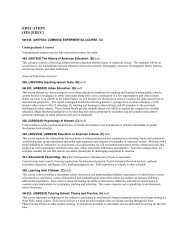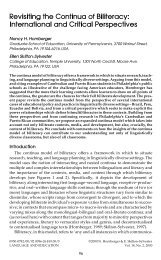Teacher turnover in special and general education: attrition
Teacher turnover in special and general education: attrition
Teacher turnover in special and general education: attrition
Create successful ePaper yourself
Turn your PDF publications into a flip-book with our unique Google optimized e-Paper software.
<strong>Teacher</strong> Turnover<br />
the need for enhanced supply. Of first-time SETs hired <strong>in</strong> 1999-00, only 46% were extensively<br />
prepared to teach <strong>in</strong> <strong>special</strong> <strong>education</strong> (the others were either prepared <strong>in</strong> <strong>general</strong> <strong>education</strong> or<br />
had <strong>in</strong>adequate preparation) (Cook & Boe). It is not surpris<strong>in</strong>g that <strong>in</strong>adequate supply <strong>in</strong>creases<br />
<strong>turnover</strong> as many SETs switch to assignments <strong>in</strong> <strong>general</strong> <strong>education</strong> for which they prepared.<br />
Benefits of Turnover<br />
Although the costs of teacher <strong>turnover</strong> are a major concern, the benefits of teacher <strong>turnover</strong><br />
should also be recognized <strong>and</strong> better understood. Unfortunately, these benefits are a neglected<br />
area of research. Our results, however, document some benefits. Of SETs who leave each year,<br />
about half are replaced by return<strong>in</strong>g experienced teachers (this was about 38% for GETs). This is<br />
<strong>in</strong>deed a “revolv<strong>in</strong>g door,” but the fact that so many former teachers return is a major asset to the<br />
field. Nonetheless, teacher <strong>turnover</strong> still entails costs, but the costs for tra<strong>in</strong><strong>in</strong>g more first-time<br />
teachers would be even higher were it not for return<strong>in</strong>g experienced teachers.<br />
In addition, much of the <strong>attrition</strong> of teachers is an asset to the field of <strong>education</strong> s<strong>in</strong>ce about<br />
one third of leavers became employed <strong>in</strong> non-teach<strong>in</strong>g positions <strong>in</strong> <strong>education</strong>. As we have<br />
shown, over four times as many leavers became employed <strong>in</strong> non-teach<strong>in</strong>g positions <strong>in</strong> <strong>education</strong><br />
the year after leav<strong>in</strong>g than became employed <strong>in</strong> other vocations.<br />
A somewhat higher rate of <strong>attrition</strong> of teachers dur<strong>in</strong>g their first three years of experience is<br />
not surpris<strong>in</strong>g, <strong>and</strong> some is probably constructive. New teachers explore the fit of their <strong>in</strong>terests<br />
<strong>and</strong> qualifications for the dem<strong>and</strong>s of the profession. Not all are suited, <strong>and</strong> hence should leave<br />
(NCTAF, 2003; NCES, 2005; Johnson et al., 2005). And as Wayne (2000) concluded, only one<br />
quarter of beg<strong>in</strong>n<strong>in</strong>g teachers leave to pursue other careers or due to dissatisfaction. Given these<br />
considerations, the somewhat higher rate of <strong>attrition</strong> for public school teachers with 1-3 years of<br />
experience is not alarm<strong>in</strong>g <strong>and</strong> some of it is constructive.<br />
Implications for Turnover Research<br />
Compared with the extensive analysis of teacher <strong>attrition</strong>, <strong>and</strong> reasons therefore, reported<br />
here <strong>and</strong> elsewhere, much more research should be devoted to underst<strong>and</strong><strong>in</strong>g the reasons for<br />
teach<strong>in</strong>g area transfer <strong>and</strong> school migration, <strong>and</strong> for <strong>in</strong>terventions that improve the retention of<br />
qualified teachers. In addition, a much better empirical underst<strong>and</strong><strong>in</strong>g of the costs <strong>and</strong> benefits of<br />
teacher <strong>turnover</strong> will be useful <strong>in</strong> assess<strong>in</strong>g tradeoffs <strong>and</strong> target<strong>in</strong>g <strong>in</strong>terventions.<br />
36


